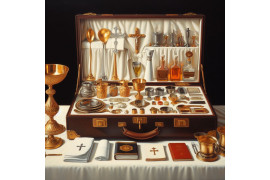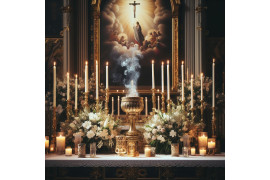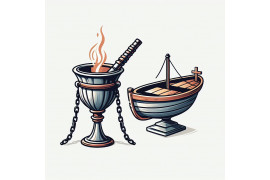"The light shines in the darkness, and the darkness has not overcome it." - John 1:5
In biblical scripture, the term "candlestick" refers to a holder for candles or lamps. Symbolizing light, illumination, and guidance, candlesticks hold significant meaning within religious contexts. In the Old Testament, these candlesticks were used in the Tabernacle and Temple for various religious rituals. They often featured multiple branches or arms to hold several candles simultaneously. The presence of candlesticks served as a reminder of God's presence and his role as a guiding light in people's lives.
Understanding the symbolism behind candlesticks can provide more profound insights into biblical narratives and teachings. Join us as we delve into the significance of candlesticks in the Bible, exploring their historical context and spiritual implications. Discover how this ancient object serves as a powerful metaphor for divine enlightenment and spiritual growth.
Symbolism: Illumination and Guidance
Candlesticks hold great symbolism in the Bible, representing spiritual illumination and divine guidance. They serve as a powerful metaphor for God's presence and light shining upon His people. Let's delve into the significance of candlesticks in biblical symbolism.
Candlesticks symbolize spiritual illumination, providing direction and clarity amidst darkness. In a world filled with turmoil and uncertainty, they represent the light of God guiding us through life's challenges. Just as a candle dispels darkness, God's light illuminates our path, helping us navigate through difficult times.
The flame on a candlestick serves as a metaphor for the Holy Spirit's guiding presence in our lives. The Holy Spirit acts as our compass, leading us towards righteousness and truth. It is through this divine guidance that we can find solace and make wise decisions.
Throughout the Bible, candlesticks are often mentioned in relation to visions or symbolic representations. In the book of Revelation, golden lamp stands are described as representing seven churches (Revelation 1:20). Each church is called to be a beacon of light in their respective communities, spreading God's love and truth.
Candlelight also holds in-depth meaning. During times of religious persecution in ancient Rome, Christians would gather secretly under cover of darkness with candles to worship together. The flickering flames served as a reminder of their unwavering commitment to Christ despite facing immense adversity.
Moreover, candlesticks have been associated with good works throughout different ages. In Matthew 5:14-16, Jesus encourages his followers by saying, "You are the light of the world... let your light shine before others." This passage emphasizes the importance of living out our faith through acts of kindness and compassion.
In Zechariah 4:2-6, there is a vision where two olive trees stand on either side of a golden lamp stand. The olive trees represent the anointed ones, and the central stem of the lamp stand symbolizes God's provision of oil, which fuels the flame. This imagery highlights the connection between God's provision and our ability to shine His light in the world.
To conclude, candlesticks hold profound symbolism in biblical teachings. They represent spiritual illumination, divine guidance, and the presence of God's light shining upon His people. Candlelight provides direction and clarity amidst darkness, serving as a metaphor for spiritual enlightenment. The flame on a candlestick signifies the Holy Spirit's guiding presence in our lives. By understanding the significance behind these symbols, we can gain a deeper appreciation for their meaning and apply their wisdom to our own spiritual journey.
Biblical References to Candlesticks (e.g., Revelation)
In the Bible, candlesticks hold significant symbolism and are mentioned in various passages. The book of Exodus provides us with a detailed description of the construction of a golden candlestick for use in worship. This candlestick was an essential part of the tabernacle, which served as a place of worship for the Israelites during their journey through the wilderness.
Moving forward to the book of Revelation, we encounter another mention of candlesticks. In this apocalyptic book, Jesus is depicted amidst seven golden candlesticks, symbolizing His church. These seven separate candlesticks represent different churches with their unique characteristics and challenges.
John's vision in Revelation emphasizes that Jesus holds authority over these churches' spiritual well-being. Each church is addressed individually, highlighting their strengths, weaknesses, and areas where they need improvement. This representation serves as a reminder that Jesus cares deeply about each congregation and desires their growth and faithfulness.
The concept of the seven golden candlesticks can be seen as an encouragement for believers throughout different eras and church ages. It signifies that Jesus is present among His people at all times and continues to guide them through various circumstances.
It's important to note that while these references to candlesticks are found in the New Testament, they have roots in the Old Testament as well. The construction of the golden candlestick described in Exodus foreshadows its significance in Revelation.
The golden candlestick mentioned in Exodus had seven branches adorned with almond-shaped cups holding oil lamps. These lamps provided light within the holy place of the tabernacle, representing God's presence illuminating His people's path.
This symbolism aligns with Jesus' words when He said, "I am the light of the world" (John 8:12). Just as the physical lamp stand illuminated the tabernacle, Jesus brings spiritual illumination and guidance to His followers.
In addition to providing light, candles also serve as symbols of purity and devotion. The golden candlestick represents the purity of God's Word and His people, shining brightly amidst a world engulfed in darkness.
The biblical references to candlesticks remind us that as believers, we are called to be lights in this world. We are to shine forth the truth of God's Word, represent His church faithfully, and navigate through the challenges we face with the guidance of Jesus.
By understanding the significance of candlesticks in both the Old and New Testaments, we can grasp a deeper spiritual meaning behind their presence in biblical narratives. They serve as powerful symbols of illumination, guidance, purity, and the presence of Christ among His people.
Spiritual Meaning: Connection to Worship and God's Presence
Candlesticks have held significant spiritual meaning throughout biblical history. In various religious practices, lighting candles symbolizes reverence and a deep connection with God. The act of lighting candles during ceremonies creates an atmosphere that is conducive to prayer, reflection, and meditation.
When believers light candles on a candlestick, they are seeking communion with the divine presence of God. This act serves as a physical representation of their faith and desire to honor and connect with the holiness of God. Candles hold a special place in churches and other places of worship, as they serve as a tangible reminder of the presence of God.
The use of candlesticks in religious settings can be traced back to ancient times. In the Old Testament, candlesticks were an integral part of the Tabernacle and later the Temple in Jerusalem. These candlesticks were meticulously crafted according to specific instructions given by God Himself. They were made from pure gold, symbolizing purity and holiness.
The lighting of candles on a candlestick signifies not only the physical illumination but also spiritual enlightenment. It represents the believer's desire for guidance from God's spirit in their daily lives. Just as a lit candle dispels darkness, believers seek spiritual illumination through prayer and meditation.
In addition to their symbolism within religious rituals, candlesticks also play a role in personal devotion. Many individuals light candles at home or in local churches as an expression of their faith and devotion to God. Lighting a candle can be seen as an offering or blessing, inviting God's presence into one's life.
Moreover, candles hold significance beyond their individual flames; they represent unity within communities of believers. When multiple candles are lit together on a candlestick or candelabra during worship services or special occasions, it signifies collective prayers rising to heaven as one voice.
The spiritual meaning behind candlesticks extends beyond traditional worship practices; it permeates various aspects of believers' lives. Lighting candles can serve as a reminder to honor God in all areas of life, not just within the walls of a church. It is a symbol of faith and an invitation for God's spirit to guide and bless every aspect of one's existence.
Metaphor for Spiritual Illumination and Divine Order
The candlestick holds a significant metaphorical meaning in the Bible, representing spiritual illumination and divine order. The arrangement of multiple branches on a candlestick symbolizes the importance of divine orderliness within the community of believers. Just as each branch holds a separate flame, individual believers are united under one faith, contributing to the overall illumination of the body of Christ.
In this metaphor, each flame represents a believer who has been enlightened by the Holy Spirit. Each believer plays a unique role within the body of Christ, just as each flame contributes to the overall brightness of the candlestick. No matter how small or seemingly insignificant an individual's contribution may be, it is essential for the collective spiritual enlightenment.
A well-designed candlestick reflects harmony within the spiritual community. It signifies that every believer is connected through their faith and commitment to God. The unity and cooperation among believers create an atmosphere where wisdom and understanding can flourish.
The metaphor of the candlestick also emphasizes that spiritual illumination comes from God Himself. The flames on the branches represent not only human wisdom, but also divine wisdom bestowed upon believers through His inspired Word. As believers study and meditate on His commandments and teachings, they are illuminated with divine knowledge and understanding.
Furthermore, just as natural light dispels darkness, spiritual illumination brings clarity amidst confusion and ignorance. Through God's grace and guidance, believers gain insight into His truth and n discern between right and wrong.
It is important to note that while leaders within the church play a crucial role in guiding and nurturing believers' spiritual growth, they are not meant to overshadow or replace individual believers' connection with God. The metaphorical representation of each branch holding its own flame highlights that reliance on human leaders alone can lead to scriptural practices or misinterpretations of God's Word.
The candlestick metaphor has had profound significance throughout history. During dark periods like the Dark Ages, when access to the Bible was limited, the candlestick served as a reminder of the importance of seeking divine wisdom and relying on God's illumination rather than solely depending on human leaders.
Unveiling Hidden Messages: Decoding Symbolic Language
Candlesticks: Conveying Hidden Messages Through Symbolic Language
Candlesticks in the Bible serve as more than just a source of light; they possess a more profound meaning. These ancient objects are used as a medium for conveying hidden messages through symbolic language. The positioning and number of candles on a candlestick can hold specific meanings, offering insights into spiritual concepts and intentions.
Deciphering Meaning Through Candle Positions and Numbers
The placement of candles on a candlestick carries symbolic significance. In biblical texts, different positions may represent various aspects or stages of spiritual enlightenment or divine order. For example:
-
A single candle at the center signifies unity or the presence of God.
-
Multiple candles arranged in a line may symbolize the progression of time or events.
-
Candles placed in a circle can represent eternity or completeness.
Similarly, the number of candles on a candlestick can provide additional insights into the intended message:
-
Two candles often signify duality, such as contrasting forces or complementary aspects.
-
Three candles may represent the Holy Trinity or divine perfection.
-
Seven candles could allude to the seven days of creation or divine completeness.
Colors and Types: Spiritual Concepts and Intentions
Beyond positioning and numbers, colors and types of candles also hold symbolic meaning in biblical context. Different hues carry associations with specific spiritual concepts or intentions:
-
White candles symbolize purity, innocence, and holiness.
-
Red candles are often associated with sacrifice, love, and passion.
-
Blue candles represent peace, tranquility, and divine wisdom.
-
Purple candles signify royalty, authority, and penitence.
Furthermore, certain types of candles convey unique symbolism:
-
Tapered candles suggest growth or ascension towards enlightenment.
-
Pillar candles embody stability and endurance in faith.
-
Beeswax candles symbolize purity due to their natural origins.
Decoding Metaphorical Language in Scripture
Understanding the symbolic language of candlesticks in the Bible requires deciphering metaphors and allegories. It involves delving into the cultural and historical context of biblical texts, as well as exploring related passages for more profound insights. This process allows us to unravel hidden meanings and gain a richer understanding of spiritual concepts conveyed through candlesticks.
By examining the positioning, numbers, colors, and types of candles on a candlestick, we can uncover profound messages embedded within scripture. These symbols offer guidance, inspire contemplation, and facilitate a deeper connection with divine truths.
Understanding the Candlestick's Role in Revealing God's Truth
We have seen how they represent illumination, guidance, and connection to worship and God's presence. Just as a candlestick brings light into a dark room, it serves as a metaphor for spiritual illumination and divine order in our lives.
By understanding the more profound meaning of candlesticks, we can uncover hidden messages encoded within biblical texts. These symbolic language unveiling allows us to gain new insights into God's truth and teachings. So next time you come across references to candlesticks in the Bible, remember that they are not just physical objects but powerful symbols with profound spiritual implications.
Now that you have delved into the world of candlesticks in the Bible, why not explore further? Dive into more biblical symbolism or discover other intriguing aspects of spirituality. Keep seeking knowledge and understanding, for it is through exploration that we can deepen our faith and connection with God.
FAQs about Candlesticks in the Bible
What is the significance of candlesticks in religious ceremonies?
Candlesticks hold great significance in religious ceremonies, as they symbolize both illumination and guidance. They represent the light of God shining upon his followers, leading them on their spiritual journey.
Are there specific biblical references to candlesticks?
Yes, there are several biblical references to candlesticks. One notable mention is found in Revelation 1:12-13, where seven golden lamp stands (candlesticks) are described as representing seven churches.
How do candlesticks connect to worship?
Candlesticks play a vital role in worship by creating an ambiance of reverence and spirituality. The flickering flames remind worshipers of God's eternal presence and inspire devotion during prayer or meditation.
Can I use candlesticks for personal spiritual practices?
Absolutely! Many individuals incorporate candle lighting rituals into their personal spiritual practices. Lighting a candle can serve as a symbolic act of inviting divine presence, seeking guidance, or expressing gratitude.
Do different types of candles hold different meanings?
Yes, the type of candle used can hold additional symbolism. For example, a white candle often represents purity and spiritual enlightenment, while colored candles may symbolize specific intentions or prayers.
How can I incorporate candlesticks into my daily life?
You can incorporate candlesticks into your daily life by using them during prayer, meditation, or quiet reflection. Lighting a candle in moments of solitude can create an atmosphere conducive to inner peace and spiritual connection.
Where can I find more information about biblical symbolism?
To delve deeper into biblical symbolism and its various interpretations, you can explore reputable religious texts, consult knowledgeable theologians or scholars, and engage in discussions with fellow believers.



